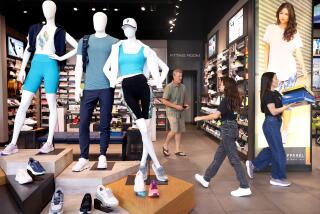The Ethnic Side of Sears : Retailer Leads in Effort to Reach Diverse Markets
- Share via
There are many elements to the retailing comeback being posted by Sears, Roebuck & Co., and one of them is represented by the size 6 women’s dress.
Until recently, the Sears store in Westminster wasn’t having much luck selling clothes to the community’s sizable Asian population. Then the store’s Asian sales associates advised the manager that advertising was not enough.
“Sales began to increase when we suggested stocking the store with more petite sizes,” said Huong Le, a cosmetics sales associate of Vietnamese descent. “That’s very important because Asian women tend to be smaller in size.”
With a multipronged strategy that ranges from bilingual sales staffs to targeted advertising and signs in Spanish at some stores, Sears has pushed to the forefront among retailers trying to reach the nation’s increasingly diverse markets, particularly in Southern California.
And the campaign is paying off. While the U.S. retail industry generated a holiday season sales increase of less than 2%--the worst in a decade--Sears posted a nationwide jump of 6.8% for the same period, partly because of strong sales at its Southern California stores, said Robert Mettler, president of the apparel and home fashions group at Sears.
Indeed, Mettler said, sales at its Southern California stores exceeded Sears’ national per-store average by 30% for the holiday season. He credited demographic strategies for part of the gain.
“We have researched the demographics and shored up our business in that area,” Mettler said of Southern California.
Sears’ bid for the Latino and Asian dollar paid dividends throughout 1995, Mettler said. Sales gains at Southern California stores with a major Latino customer base were twice as large as the sales surge at other Sears stores, he said.
And although Sears continued its retailing comeback last year by generating strong clothing sales nationwide, the percentage increase in apparel sales to Asians in the Southland surpassed the overall gains, Mettler said.
Sears, once the nation’s leading retailer, fell behind Wal-Mart and Kmart in recent years. It reached the nadir when it reported a record loss of $3.93 billion in 1992. Now, however, with annual sales up nearly 6% for the fiscal year that ends next month, the venerable retailer is expected to report a healthy profit increase.
Industry analysts and marketing experts say Sears’ ethnic strategy is a key.
“Other retailers will emulate Sears because--considering the demographic changes in the country--Sears now has a strategy for the future,” said Penelope Wong of Wong Wong and Boyack, a San Francisco-based firm that specializes in ethnic marketing.
Indeed, Latinos and people of African, Asian and American Indian heritage already account for about 25% of the U.S. population. By 2000, they will account for at least a third of all consumers. By 2010, nonwhites are projected to make up the majority of the population of California.
Minorities already comprise the majority in about half of the 90 California cities with populations of 50,000 or more, by one estimate. And so-called minorities are actually the majority in many of the nation’s major cities.
It’s no surprise, then, that at least half of all Fortune 500 companies have launched some ethnic marketing initiatives. Among retailers, Sears appears to be at the head of the pack.
The company has doubled its advertising budget for consumers of color since 1993, said Gilbert Davila, head of ethnic marketing. A substantial portion of that advertising is in Spanish and Asian-language media in cities with diverse populations.
Spending to reach Asian markets accounted for part of that increase. Sears began to spend on advertising campaigns aimed at the Asian consumer for the first time last year.
And spending on the Latino market, meanwhile, has increased. Sears ranked 13th in U.S. corporate spending aimed at Latinos in 1993, but it was No. 5 on that list for 1995 and the top retailer, with outlays of $9.5 billion, according to Hispanic Business magazine.
The company places ads in La Opinion and other Spanish-language publications in Southern California. Sears also sponsors commercials on local Spanish-language television and radio stations--spanning broadcast to cable, FM to AM, and ranging from young adult formats to programming for middle-aged audiences.
The sounds of Sears’ commercial messages in Spanish resonate with many of the Latino shoppers browsing the malls of a state with historical and contemporary connections to the language. Sears has operated in Mexico for decades, so it is already a familiar name to immigrants.
“It makes you feel special,” said Jesus Padilla of San Bernardino, a frequent Sears shopper who recently was at the Puente Hills mall in the City of Industry. “The Latino community keeps hearing about Sears products. And when you need something, you think of Sears.”
In a bid to keep thoughts of Sears in Latino homes, the company sponsors publication of Nuestra Gente, a general interest Spanish-language magazine that it mails nationwide to homes of Latinos on the company’s mailing list.
The magazine is also available in many of Sears’ Southern California stores, with much of the distribution concentrated in Los Angeles and Orange counties. Of 29 Sears stores in a region stretching from Santa Barbara to Laguna Hills, 21 are in communities with populations that are at least 30% Latino, according to Sears studies. Another six Sears stores are in Los Angeles or Orange county communities with populations that are at least 20% Asian, Sears says.
The Sears in the Orange County city of Westminster has a significant Asian American customer base, much of it Vietnamese. The shift to smaller sizes, advertising in Vietnamese-language newspapers and on radio and the presence of bilingual salespeople in each department helped boost sales significantly in 1995, said Betty Hercus, general manager of that Sears store.
“Sears is giving immigrants a feeling of comfort by providing sales personnel who speak their language,” said Jerry Walters, head of Jerry Walters Marketing Services, a Santa Monica-based company specializing in the Asian market. “Immigrants tend to network more, and if they have a pleasant experience at a store, they will make recommendations to friends. These measures will pay off even more [for Sears] in the future.”
Sears also has been aggressive in reaching out to ethnic communities, said Joe Diaz, general manager of the Sears store at the Puente Hills mall.
Diaz helps coordinate Sears’ involvement in many Asian and Latino cultural festivals--events such as the Vietnamese Tet Festival, Chinese New Year and Cinco de Mayo.
Sears takes part in dozens of such Southern California festivals each year--sponsoring bands and contests at some, and soliciting business for Sears credit cards at every events.
“It’s not enough to make people feel comfortable at your store,” Diaz said. “Sometimes you have to go out and welcome them in.”
More to Read
Inside the business of entertainment
The Wide Shot brings you news, analysis and insights on everything from streaming wars to production — and what it all means for the future.
You may occasionally receive promotional content from the Los Angeles Times.










